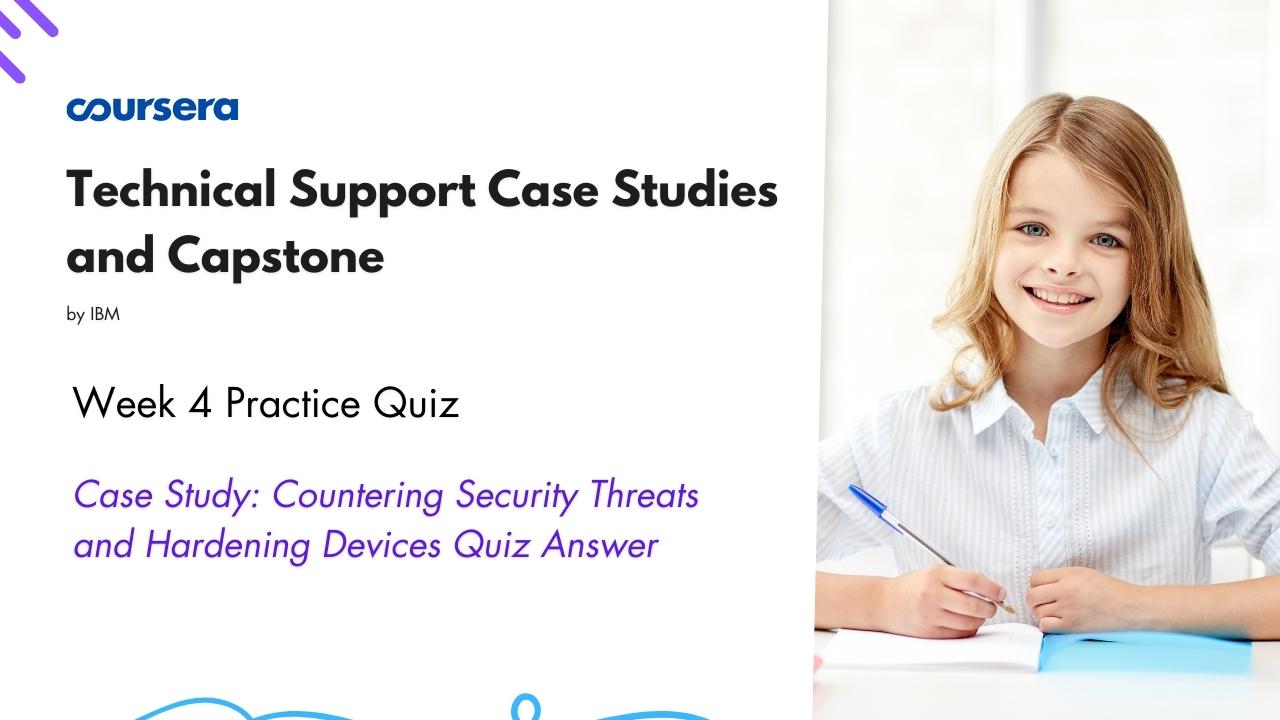Case Study: Countering Security Threats and Hardening Devices Quiz Answer
In this article i am gone to share Coursera Course: Technical Support Case Studies and Capstone Week 4 Practice Quiz | Case Study: Countering Security Threats and Hardening Devices Quiz Answer with you..
Enroll Link: Technical Support Case Studies and Capstone
Also visit: Case Study: Security and Information Privacy Quiz Answer
Case Study: Countering Security Threats and Hardening Devices Quiz Answer
Terrance is a service desk technician. He answers a call from Veronica, another employee at the company, and the following exchange ensues:
Technician: Hello, this is Terrance with technical support. How may I help you today?
Employee: Terrance, this is Veronica. When I try logging into my work account, I get a message saying thatI need to change my password and set up something called multifactor authentication. I don’t understand why I need to do either. Everything is working fine as is.
Technician: I understand your frustration; no one wants to feel like they’re jumping through a bunch of hoops just to do their job!I’d be happy to discuss why we’re asking everyone to do this, and I can also help you set up your new password and multifactor authentication, or MFA for short.
Employee: Sure thing, Terrance. Let’s start with the password. It feels like I have to change my passwordconstantly, and it’s annoying. Why do I need to keep changing it, and why are the requirements for each password so strict?
Technician: Those arereasonable questions, Veronica, and people ask them a lot!
Question 1)
How frequently should employees be required to change their passwords?
- Every 6 to 12 months
- Every 120 days
- Every 90 days
- Every 12 to 18 months
Technician: Everyone can help protect against data breaches by updating their passwords regularly. That way, if someone steals your password, it may expire before a bad actor uses it. Our password policy requires that employees change their passwords every six months.
Employee: I guess that makes sense. So, what’s the deal with MFA? Why do we need to bother switching to that?
Technician: That’s a great question. Up to this point, all employees have been using single-factor authentication, or SFA for short. With SFA, you only need to enter one identification factor, or credential, to log in.
Question 2)
What is the most common identification factor in single-factor authentication (SFA)?
- Biometric characteristic
- Security question
- Password
- OTP code
Technician: The most common credential in SFA is your user name and password, and that’s the one that everyone has been using at our company.
Employee: Right. So what’s wrong with SFA? I haven’t had any issues with it, and I don’t think anyone else has, either.
Question 3)
What are three threats to single-factor authentication (SFA)? Select all that apply.
- Closed website accounts
- Keystroke loggers
- Dark web data breaches
- Phishing attempts
Technician: SFA is not safe from data breach information sold on the dark web, keystroke loggers, and phishing attempts.
Employee: And MFA is not vulnerable to those threats?
Technician: MFA is not 100% fail-proof, but it significantly reduces the risk of a breach. With MFA, you need more than just your correct password to log in; you also need one or more additional credentials.
Question 4)
What is an identification factor that you might use as part of multifactor authentication (MFA)?
- Driver’s license
- FM radio
- Security key
- Print mail
Technician: The additional credential could be something else you know, like the answer to a security question such as “In what city were you born?” The credential could also be something you have, like a security key device that you plug into your USB port. It could even be something about you, like your fingerprint, face, or voice.
At our company, the additional credential will come through your cell phone. You will receive a one-time password (OTP) code through text or voice message, and then you will enter this code to log in.
By requiring additional credentials, MFA makes hacking into your account far more difficult for cybercriminals, in turn making your files—and our company’s assets—safer.
Employee: Okay, that makes sense. I think I’ve even had to use MFA for my personal email and other important accounts. How do I set up MFA for my work account?
Terrance talks Veronica through creating a new password and using her phone for MFA. Veronica logs into her work account successfully.
Employee: Great! Are there any additional measures I should take to protect my account?
Technician: Yes! I would harden any devices associated with accessing your account – hardening is the process of securing a device to minimize security vulnerabilities. These devices include your work laptop and the cell phone that you’re using for MFA.
Question 5)
What is a measure that Veronica should take to harden her devices?
- Use public wifi.
- Disable unused features.
- Turn off firewalls.
- Open computer ports.
Terrance explains numerous ways that Veronica can harden her devices, such as disabling unused features and ports, updating firmware and software, and using firewalls, VPNs, and anti-malware applications. Veronica thanks Terrance for his help, and the call ends.

